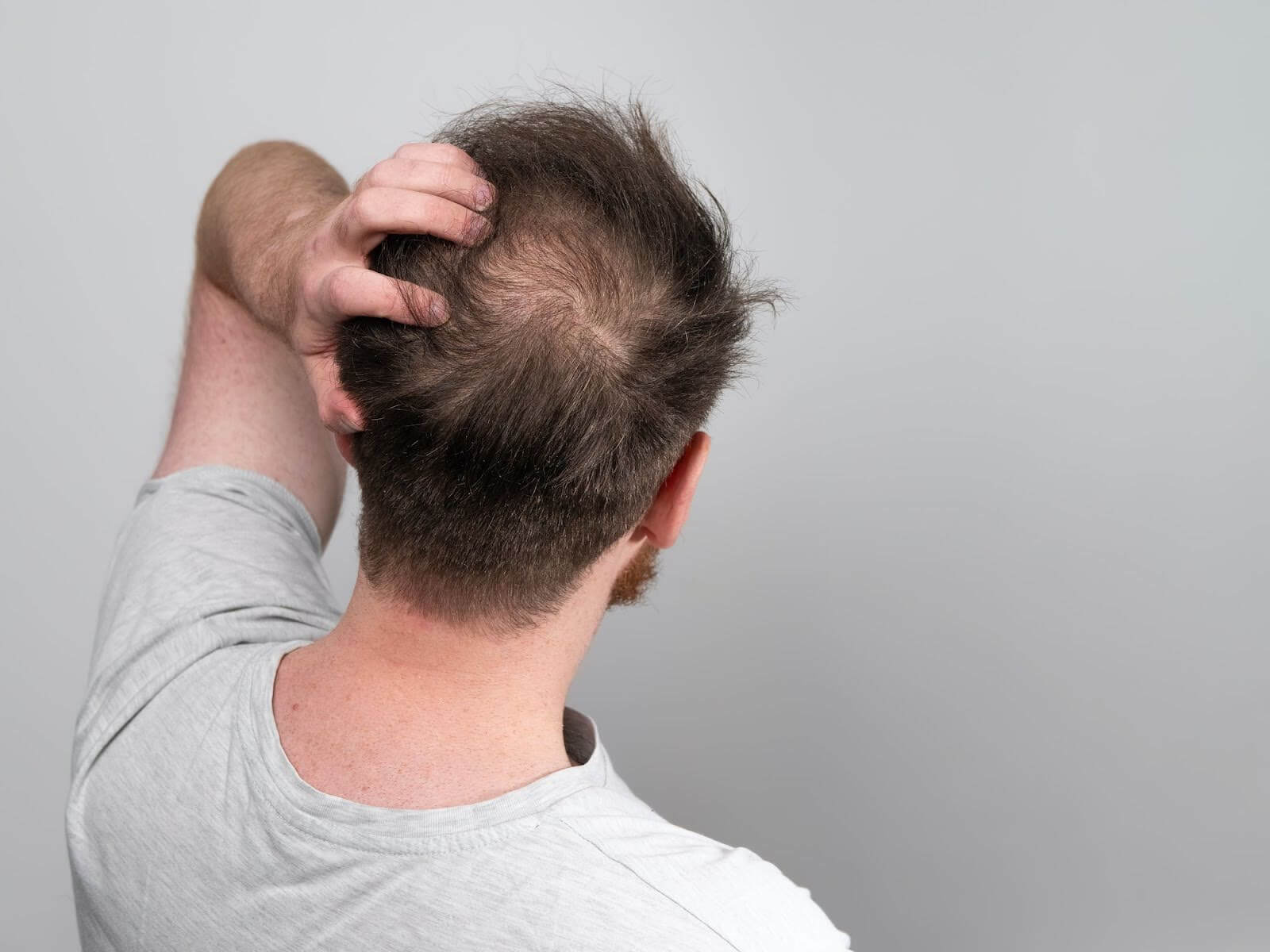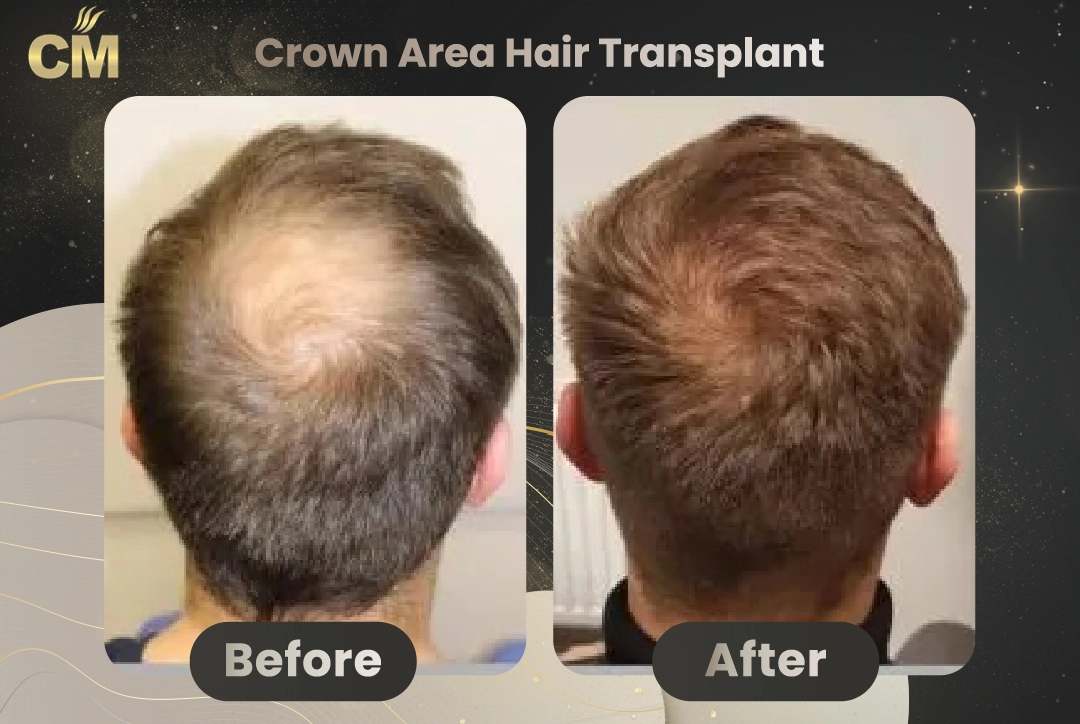Crown Hair Transplant in Turkey
Crown hair transplant is a specialized procedure to restore hair in the crown area and is closely related to what many call the hair transplant crown timeline which is often one of the most difficult and complex areas to treat in hair restoration. Unlike other parts of the scalp, the crown (or vertex) is where hair loss patterns tend to form a whirl or spiral, making the restoration process more complicated. This procedure requires not only surgical precision but also deep understanding of the natural direction and pattern of hair growth to achieve a natural result.
Hair Loss in the Crown
There are several reasons why hair loss occurs in the crown area. One of the most common cause is androgenetic alopecia (male or female pattern baldness) which starts from the temples or crown. Hormonal imbalances, stress, poor blood circulation, aging can also contribute to progressive thinning in this area. Some individuals may experience hair loss in the crown due to nutritional deficiencies, autoimmune disorders or excessive use of harsh hair products.
Hair loss in the crown area is a common concern especially for those looking for a hair transplant for thinning crown, affects individuals of all genders but most commonly seen in those with male pattern baldness. But good news is hair transplant in Turkey is a transformative solution to get a natural and youthful look. Whether you are looking for a hair transplant for thinning crown or complete crown balding hair transplant, modern techniques give excellent results.
Complexity of Crown Hair Transplants
hair transplant surgeries are more complicated than other hair restoration procedures because of the unique characteristics of the crown area:
- Multi-Directional Hair Growth: Hair follicles in the crown grow in different directions. So surgeons must place grafts very precisely to achieve a natural look.
- Weak Blood Circulation: Reduced blood flow in the crown can affect graft survival rates. Specialized techniques like FUE hair transplant and DHI crown area transplant help overcome this challenge.* Natural Density: The crown naturally has lower hair density. Replicating this natural look while ensuring optimal coverage is a challenge.
Hair Transplant for Crown Area – Procedure Steps
Drawing the crown area lines
Restoring the hair of crown area requires a strategy. During the initial evaluation the surgeon examines the pattern of hair loss, scalp flexibility and overall donor area capacity. Since crown area thinning often follows a spiral pattern, designing the restoration plan demands careful drawing to ensure natural growth flow.
Donor Area Preparation:
After applying local anesthesia on the donor area, the surgeon uses the FUE technique to extract individual follicular units. For crown hair transplant it’s important to select healthy, robust grafts that can withstand placement in areas of thinner circulation.
Smooth Experience, Start to Finish
Crown restoration takes several hours but is a minimally invasive procedure. Patients stay awake and relaxed throughout, thanks to local anesthesia. Breaks for meals or rest are available and the team ensures comfort at every stage of the process.
Restoring The Crown
One of the key challenges in crown hair transplantation is recreating the natural swirl or spiral of hair growth. The surgeon opens tiny incisions based on the natural direction and curvature of the crown area.
High-Precision Graft Implantation
Once the channels are prepared, the surgeon begins placing the grafts one by one. The density is adjusted to create a natural transition from the center of the crown to surrounding areas. Since the crown tends to require more grafts for full coverage, careful spacing and direction control is essential to avoid an unnatural look.
Gentle Aftercare
After the procedure the donor area is lightly dressed and patients receive complete instructions for home care. The next day they return to the clinic for the first gentle wash, where the team demonstrates proper cleansing techniques and reviews the healing schedule. Special care ensures grafts settle securely and begin the growth cycle.
Crown Hair Transplant Growth Timeline
Does the crown take longer to grow after a hair transplant? Yes, it often does, which raises a common question: how long does the crown take to grow after hair transplant? Patients typically see initial signs of growth between 4–6 months. Full results are usually visible by 12 months. This extended hair transplant timeline is due to the unique vascular structure and hair direction in this region.
How Many Grafts for Crown Hair Transplant?
Number of grafts required varies depending on the degree of baldness. On average 1,500 to 3,000 grafts may be needed to achieve sufficient coverage depending on the size of the balding area and the patient’s hair characteristics.
Crown Hair Transplant Success Rate
With proper technique and post-operative care, the hair transplant success rate in Turkey is high. ClinMedica reports excellent results using advanced methods and customized planning for crown area restoration.
Post-Procedure Care and Expectations
Proper preparation and post-operative care is key to optimal results:
- Before Procedure: Avoid certain medications and alcohol, follow pre-op instructions.
- After Procedure: Gentle washing, avoid sun exposure, follow medication plans.
Crown Hair Transplant Cost in Turkey
Cost of hair transplant in Turkey varies:
- Clinic Reputation: Established and well-known clinics may charge more.
- Surgeon’s Experience: Highly experienced surgeons may charge more.
- Package Inclusions: Many clinics offer all-inclusive packages including accommodation, transportation and post-operative care.
For patients comparing options, hair transplant crown cost in Turkey is one of the most affordable globally without compromising on quality.
Crown Hair Transplant Results
Crown area takes longer to show final results than the frontal area. Patients see visible growth between 4-6 months, full density around 12 months. Crown area hair transplant before and after photos show huge difference in natural volume and hair pattern when done correctly.



